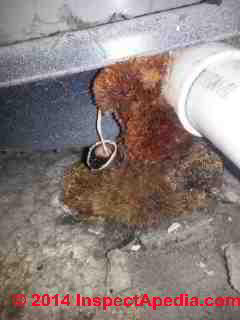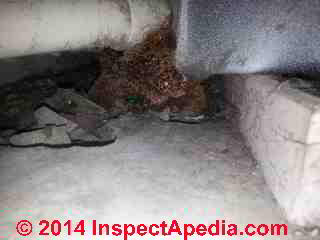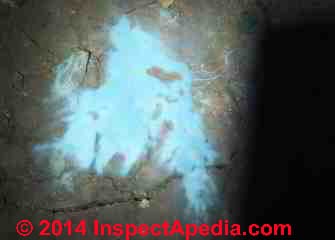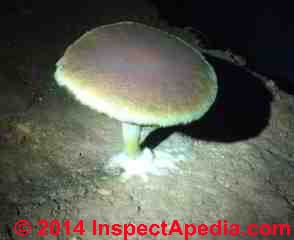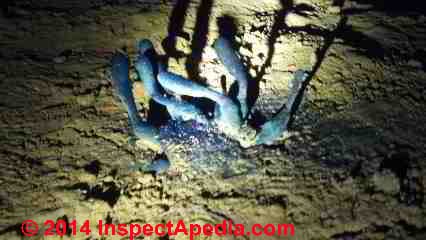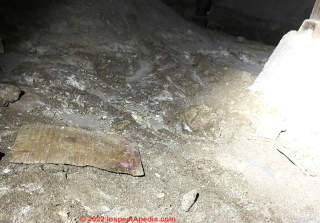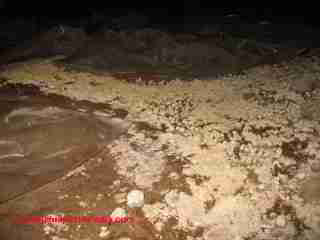 Mold on Dirt in Crawl Spaces, Basements, Floors
Mold on Dirt in Crawl Spaces, Basements, Floors
5 Steps to fix a dirt-area mold problem
- POST a QUESTION or COMMENT mold growth on dirt in basements, crawl spaces, or other areas.
Identify & fix mold growth on dirt & soil in, under, around building crawl spaces.
This article explains how to find, identify, clean up or prevent mold growing on dirt or soil surfaces such as in building crawl spaces or in dirt floor basements.
We include five simple steps for dealing with mold growth on the dirt floor of a basement or crawl space.
Watch out: Yellow mold in crawl spaces may be destructive Meruliporia fungus. White mold found on crawl space or basement dirt floor may be a basidiomycete. Photographs of mold growing on dirt crawl space floors - soil fungi under or in buildings. Indoor "mushrooms" growing in or on buildings.
Our photo (above) shows thick pale yellow fungal growth on dirt in a damp crawl area.
InspectAPedia tolerates no conflicts of interest. We have no relationship with advertisers, products, or services discussed at this website.
- Daniel Friedman, Publisher/Editor/Author - See WHO ARE WE?
Mold on Dirt in Basements & Crawl Spaces
 Significance of Indoor Soil Fungi - "Dirt Mold" growing in building basements & crawl spaces
Significance of Indoor Soil Fungi - "Dirt Mold" growing in building basements & crawl spaces
A broad range of fungal species among at least seven genera may be found growing on or in soil [1] and because the interaction between soil and seed fungi has been studied widely in work on plant pathogens, they are studied worldwide.
[Click to enlarge any image]
However, texts that help identify soil fungi may be incomplete when it comes to mold on or in or beneath buildings.
Building conditions that produce mold growth may generate fungi that vary from how they may appear in the lab in a culture plate, and building mold, even mold on dirt in a crawl space may appear different from the same genera/species growing in nature, say in the woods.
And because mycologists so often study fungi prepared from cultures, in my (DJF) experience, texts used as identification guides may present photographs of fungi that do not necessarily match what these same genera and species may look like when found in nature.
Here we provide photographs of fungi (mold) growing on soil in or beneath buildings.
Also see MUSHROOMS IN or NEAR BUILDINGS
This article does not address the much larger topic of the genera of soil fungi. For that topic see Tsuneo Watanabe, Pictorial Atlas of Soil and Seed Fungi, Morphologies of Cultured Fungi and Key to Species, [at Amazon.com] Second Ed., CRC Press 2002, ISBN 0-8493-1118-7. [Disclosure: Amazon pays us a pathetic pittance on the sale of books listed here].
What is the Significance of Soil Fungi In a Building?
Our photo (left) shows a fungal fruiting body or mushroom growing out of a concrete block basement foundation wall. The yellow fungus growing on the mushroom may be a second opportunistic parasite.
Depending on genera/species a mold growing on dirt might be toxic, pathogenic, or allergenic, though in our experience (warning, we are not a mycologist).
Interestingly Watanabe reports that some of the mold genera commonly found as problematic mold reservoirs inside buildings or on building surfaces also include species found in soil, including two Stachybotrys species, S. corda and S. elegans, and a still longer list of Aspergillus species: including Aspergillus brevipes, Aspergillus fumigatus, Aspergillus niger, Aspergillus parasiticus, and others.
The growth of fungi on or in "dirt" below a building, say in a wet crawl space, should come as no surprise: soils both under buildings and in more natural settings (the woods) contain organic matter that contains nutrients inviting to molds.
Previously I had stated here that the chance that mold from crawl space dirt passes throughout a building as problem spores is lower than otherwise, principally because of the wet conditions in crawl spaces, but on learning that some easily airborne genera such as Aspergillus may be present, I have amended that position.
What to Do about Mold on Dirt Under a Building: 5 Steps
Many readers have asked us what to do about mold found growing on crawl space dirt or on a dirt basement floor.
I've often seen orange and yellow molds and yeasts growing on wet dirt in these areas. After the following summary we'll offer more-detailed suggestions for dealing with mold on the dirt floor of a crawl space or basement.
- REMOVE obvious heavy fungal or mold growth from the dirt surface
- INSPECT for and clean off or remove mold from other surfaces in the same area
- DRY OUT The dirt-floored area and stop the water or moisture sources
- INSTALL a 6-mil or heavier poly / plastic vapor barrier over the dirt surfaces
- CHECK for rot or insect damage in the area
Below we expand on those five steps for dealing with mold on dirt under buildings.
Step 1: Remove Mold Contamination From a Dirt-Floored Area
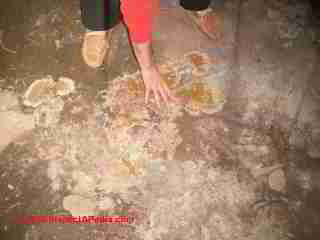 First let's note that most soil fungi that are happy in wet soil are not likely to be airborne contaminants in the building above.
First let's note that most soil fungi that are happy in wet soil are not likely to be airborne contaminants in the building above.
However the same conditions that produced those fungi that you see on the dirt surface may also produce more worrisome fungal genera/species that are easily airborne but sometimes harder to see, such as Aspergillus sp. or Penicillium sp. So it makes sense to clean up and dry out a wet dirt-floored crawl or basement area.
Photo: Meruliporia incrassata mold on dirt according to the reader who sent us this photo. [Click to enlarge any image]
"Cleanup" of moldy dirt means, at most, scraping or very shallow (1" is enough) digging; this will NOT stop mold growth but it'll remove the fruiting bodies and might slow the growth of further mold; Do not launch an expensive / extensive digging and soil removal project.
It's not likely to be needed nor helpful.
You'd have a heck of a time removing all mold and even if you could, until you correct the conditions that caused the mold growth mold will return anyway - all mold genera/species are everywhere all the time - in air, looking for a nice place to land and grow.
IF the area of mold on dirt is large, more than 30 sq. ft.,
AND if it's not a harmless cosmetic mold, professional cleanup would be appropriate, but only after a competent and independent (independent from the cleaning company) inspection diagnosed the extent and cause of mold and thus provided you with a mold cleanup plan.
Should you test the mold on the dirt? Probably not.
You do not normally need to "test" the mold to identify it since that won't change the cleanup and prevention measures.
If you see a large area of moldy soil that appears homogenous in character (color, pattern, growth surface, etc) then it may be economical to collect a sample to send to an independent lab for identification
(mine or any independent mold testing lab - we give instructions on how to collect mold samples
at MOLD TEST KIT PROCEDURES.)
Really? Mold testing to identify the genera/species is not needed nor useful unless you need to know the identification of the specific molds present for medical reasons (ask your doctor) or to permit a later check against the possibility of cross-contamination from a large, costly mold remediation job.
The mold cleanup and prevention measures are the same regardless of the mold genera or species.
Step 2: Check for & Clean or Remove Other Mold Contamination or Other Mold Friendly Stored Items
 Besides looking at the mold on the dirt floor, be sure to also check wood framing, wood subflooring, any stored items such as boxes.
Besides looking at the mold on the dirt floor, be sure to also check wood framing, wood subflooring, any stored items such as boxes.
Note that insulation may be moldy even if it looks clean, particularly if the insulation has been exposed to a large area of mold growth on wood, paper, or other mold-friendly materials nearby.
Remember also to remove junk stored in the area that invites mold growth such as cardboard boxes, old furnishings, and that Barbie townhouse that was left by your kids back in 1982.
If fiberglass insulation has been exposed to high levels of airborne mold on wood surfaces it's probably best to remove it, clean the surfaces, and re-insulate once the area is dry and clean.
An example of using media blasting to clean wood surfaces in a hard-to-access area is
at MOLD CLEANUP, WOOD FRAMING & PLYWOOD
Mold on Crawl Space Dirt? Look Up!
More significantly, the conditions of moisture and presence of organic matter such as wood framing and also hospitable moisture holding materials such as fiberglass insulation all mean that where you see mold on dirt in a crawl space you should be looking "up" to inspect the building walls and floor structure overhead for other mold growth that could be a problem.
See INSULATION MOLD CONTAMINATION TEST
An inspection of wood framing and subfloor over a damp moldy
dirt-crawl space or basement should be conducted using light and careful examination of the surfaces.
See MOLD in BUILDINGS
and
also USING LIGHT TO FIND MOLD - how to use light when looking for mold.
In any event, ne would want to be careful not to get mold in a cut, or in your eye, even if it does not appear to be an airborne species that can be easily inhaled.
See FIBERGLASS INSULATION MOLD.
MOLD in BUILDINGS describes how to find mold and test for mold in buildings, including how and where to collect mold samples using adhesive tape - an easy, inexpensive, low-tech but very effective mold testing method.
See TEST KIT for DUST, MOLD, PARTICLES: INSTRUCTIONS for details). This procedure helps identify the presence of or locate the probable sources of mold reservoirs in buildings, and helps decide which of these need more invasive, exhaustive inspection and testing.
Remove Other Nutrients Encouraging Crawl Space Mold and Mold on Dirt
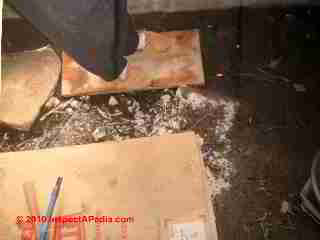 Mold might also be growing apparently on dirt but actually on something that spilled or was left atop the dirt -
Mold might also be growing apparently on dirt but actually on something that spilled or was left atop the dirt -
which could mean other fungal species than the soil fungi we just cited.
In any case if there is only a small amount of mold - a few square feet - it's reasonable for a homeowner to remove the visible mold and surface soil - just an inch or less.
There may be fungal components deeper in the soil, but we're going to address that by drying out the area rather than digging up the whole house.
Our photo (left) of white-colored mold on dirt , was contributed by a client whose crawl space contained Meruliporia sp. fungus on the dirt (see below).
We did not process a sample to identify this white fungus in the lab.
It may be a different species from others in the crawl area, and its growth may have been related to items such as cardboard or wood left on the dirt floor, or due to a buried concrete block - notice the roughly rectangular pattern of the white mold growth at the center-right in the photo.
But before sampling what looks like "white mold" on dirt or on a masonry surface, take a look
at EFFLORESCENCE & WHITE or BROWN DEPOSITS - very often the white crystalline looking substance in these locations is not itself mold, though it is a moisture indicator, meaning mold may be nearby.
Step 3: Dry out the dirt-floored crawl space or basement area
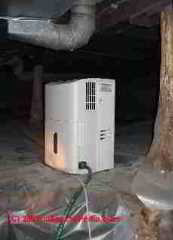 Dry out the area. It's essential to also find and correct the cause of mold growth:
Dry out the area. It's essential to also find and correct the cause of mold growth:
This includes fixing outside sources of water such as improper roof drainage and improper surface grading.
Also check that no plumbing drains or supply piping are leaking into the area.
Any mold cleanup anywhere in a building, whether its on crawlspace dirt or basement soils, must be followed by a diagnosis and correction of the moisture source that invited the mold growth, or the mold problem will simply recur.
To speed dry out of a wet area we may use dehumidifiers connected to a condensate pump or draining to a sump pump by gravity so that the dehumidifier can be left running constantly.
We might make temporary use of fans to move air around to speed the dehumidification process.
Keep in mind that dehumidifying won't work if there is still water entry from anywhere.
Watch out: drying out mold, particularly Aspergillus sp. or Penicillium sp. on wood or paper surfaces can result in a temporary but enormous surge in the level of airborne mold.
So for large areas of mold contamination (more than 30 sq .ft.) the professional remediators whom you hire will doubtless also set up temporary negative-air machines (NAMs) to blow air out of the basement or crawl space so that mold spores don't get to enjoy irritating the building occupants on floors above.
See CRAWL SPACE DRY-OUT PROCEDURE for a good place to start fixing damp or wet crawl spaces
See WET BASEMENT PREVENTION for more help with drying out wet basements and preventing water entry
Step 4: Put Down Plastic over Dirt Floors
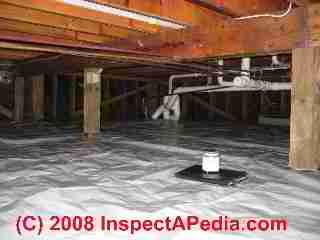 Install a 6-mil or heavier poly / plastic vapor barrier over the dirt surfaces and up walls about a foot; ideally you'd seal or affix the plastic to the walls.
Install a 6-mil or heavier poly / plastic vapor barrier over the dirt surfaces and up walls about a foot; ideally you'd seal or affix the plastic to the walls.
Plastic will break the natural "moisture pump" that occurs when wet soil is below a building:
moisture evaporating into the air above the soil actually acts as a pump to draw more soil-moisture upwards: the dirt under the building, fed by an outdoor moisture source or by indoor leaks, continues to pump moisture into the structure.
See CRAWL SPACE GROUND COVERS for details.
Optionally, if you want extra moisture-proofing of the area you might consider, once it's been cleaned of mold, spraying a fungicidal sealant on the wood surfaces of the basement or crawl space ceiling and sill plates.
See FUNGICIDAL SEALANT USE GUIDE for more information.
Our photo shows a white moisture barrier over the soil of a crawl space where a significant mold reservoir has been removed from the wood surfaces above (the floor framing, supporting girder, and posts).
You'll note the shiny appearance of the wood. [Click to enlarge any image]
The mold remediation contractor who handled this job elected to seal the wood surfaces after the cleanup was complete.
While the long-term life of fungicides that may be included in some sanitizers and sealants varies, the fact that the wood surface is sealed retards its moisture uptake so that in our OPINION that alone would help retard future mold growth.
Step 5: Check for Other Damage: Rot or Insects
Check for wood-rot or insect damage by a careful examination of wood framing and subfloors: wet crawl areas and basements invite both fungal and insect pests that can damage the structure.
The fungus in the moldy dirt floor photo above in this article was mailed to us by a client and was identified as Meruliporia incrassata - a mold that can attack wood structures causing significant damage.
We discuss this fungus at MERULIPORIA HOUSE EATING FUNGUS.
Although this recently-built home, located at 5500' in the Sierra Nevada mountains had crawl area ventilation, snow melt draining towards the structure caused chronic wet conditions and was surely a significant contributor to this mold growth.
Furthermore, and possibly more important, soil mold in a basement or crawl space is an indicator of wet conditions, which means that more-problematic molds may be growing on wood or paper or other organic surfaces nearby - and may be more of a problem for building occupants.
For example if insulation were installed in this crawl space ceiling it would be likely to have mold contamination, though more likely from Aspergillus sp. or Penicillium sp. - different fungal genera/species prefer to grow on different materials.
...
Reader Comments, Questions & Answers About The Article Above
Below you will find questions and answers previously posted on this page at its page bottom reader comment box.
Reader Q&A - also see RECOMMENDED ARTICLES & FAQs
Reader Question: mold on dirt floor around my water heater - Indoor Fungi - "Mushrooms" Found at Building Foundations, Penetrations, Plastic Piping
This growth was discovered last week on my hot water heater pvc pipe. It has contact with water it looks like because the water heater has a slow leak that maintenance never fixed. The water is about half way up in the pan that the heater sits in.
My maintenance man was going to spray it with bleach and remove it but I am terrified of what it is and if it's harmful!
My central A/C and heater sit directly above the water heater in a small closet. I insisted that they have someone come out and test a sample of it. They had a company come out but they have not told me any results. The guy did tell me when he was here that he's never seen anything like it.
He said he's seen similar looking fungus but never in an indoor environment and especially on PVC to a hot water heater. The results will go to my apartment manager so I am dependent on them to tell me. Can anyone tell me what this could be? I'm am very worried about this.
My last email would only allow one picture due to it's size so I am sending another pic in this email to show the front side of this unusual fungus growth on my water heater PVC. I have looked everywhere and cannot find anything online that comes close to resembling this. - R.S. Madison TN, 3/30/2014
Reply: don't bother bleaching mold; remove it.
A competent onsite inspection by an expert usually finds additional clues that would permit a more accurate, complete, and authoritative answer than we can give by email alone. For example I pose some additional investigative questions below. And you will find additional depth and detail in articles at our website. That said I offer these comments:
A mycologist might recognize your indoor mushrooms, but I can't positively identify your fungus from the photographs. The chief fungal growth certainly looks like coral fungus or a coral slime fungus.
Depending on the genera/species, e.g. Ramaria formosa or Ramaria gelatinosa, these are poisonous - that is, not edible. Your first photo at above left also sports an upside-down (dying) basidiomycete-like black gilled mushroom. More indoor mushroom growth examples are shown and discussed
at YELLOW MOLD PHOTOS and
at our more lengthy catalog of fungi, mold & mushrooms growing on building contents & materials:
See MOLD APPEARANCE on VARIOUS SURFACES.
In any event there is certainly no reason to panic. The total quantity of fungal material in your photos, if that's all there is in the building, is trivial. Typical standards calling for professional mold cleanup involve areas of 30 sq. ft. of continuous moldy surfaces or more.
Furthermore, "bleaching" fungus is an incorrect approach to the problem and IF there is mold growth in your building that might release irritating or harmful airborne spores or MVOCs the correct approach would be to remove the fungus -clean it off - and correct the cause for its growth.
- Please see MOLD CLEANUP with BLEACH for an explanation of why bleaching is not a correct approach
- See MOLD / ENVIRONMENTAL EXPERT, HIRE ? for an explanation of how one decides if expert assistance is probably required
- See MOLD CLEANUP GUIDE to GET RID OF MOLD on how to clean up mold and fungal growth in buildings.
- Also see MUSHROOMS IN or NEAR BUILDINGS
What makes sense to me would be a more thoughtful inspection for the leaks and water entry that encouraged this fungus to grow in the first place. "Bleaching it" without correcting the cause for growth would be pointless and risks leaving a larger but more hidden problem in the building .
Reader follow-up:
Tank you for your very prompt and informative reply! I totally agree that the underlying cause of this is crucial. If this is the coral type of fungus, which I know you can't guarantee from a pic, would drinking my tap water and brushing my teeth expose me to ingestion of the toxins?
I know that may be a stupid question but my lack of knowledge on these things has my paranoia at extremes since seeing this thing!
My maintenance guys were supposed to replace the hot water heater back in November of last year due to the possible slow leak but have never addressed it.
It took me almost a year to get my porch door replaced that was rotting all inside the frame.
That was done last week by a contractor that my apartments hired.
While he was here I asked him to look at my water heater and he is the one that noticed the growth! I would have never noticed it because it looked like expanding foam from a distance and the mushroom is growing from the backside that I can't see.
I snapped a pic of the back with my phone camera and that's when I saw the mushroom!
I will most definitely let you know what the outcome is on this! When will you be putting up my pics in your article? Will having me as the contributor better able me to receive responses to possible underlying causes? If so, then yes please do so.
Reply:
I guess the only "stupid" question is the one not asked.
But I cannot imagine how a fungus growing in soil or on a foundation wall or even touching the outside of a PVC plumbing pipe would introduce toxins into the water supply. Now IF a fungus had invaded a pipe interior that might be a different matter but, then, you'd surely also see if invaded from the outside such a pipe would also be leaky.
Are we sure we're looking at a PVC water supply pipe? - from the scale of the photo I was not sure this wasn't a drain line.
Reader Question about Mold in Dirt Crawl Space
Hi I have attached a few pics of the mold growth on my dirt crawl space each pic is isolated and no further spread is seen anywhere else.
I was actually shocked to see this strange looking growth. I do keep the crawl vents open but there is no forced air movement at all. Please assist as to how to safely remove.
The house sustained a fire in may of 2014 and the ac system has been off since. There are fans running in house though.
The only power to crawl space is to the sump pumps that discharge any water to the outside via pipes which none of the pics of the mold spores / mushrooms are even close to the sump liners of perimeter pipe in perimeter ditch.
There is no black plastic liner on dirt floor and no floor joist insulation, I removed all several years back when I dug my perimeter ditch and sump pits with the plastic liners. Thanks for any guidance! - G.E. 9/8/2014
Reply:
What lovely crawl space mold photographs. And your blue fungus one I've not seen before in buildings.
Most likely these grow where you see them because of a combination of moisture and organic material spilled on or in the soil.
Your note describes a damp or wet crawl area and one that was probably severely soaked - even flooded when the building fire occurred.
These conditions invite mold growth, but it's ongoing moisture that keeps it going and looking so fresh as in your photos.
You can dig out (just an inch or so) the visible mold, toss it into the woods or into garbage, then put down plastic, and take other steps to dry out the area.
Probably more important than the mushrooms found growing in this dirt crawl area would be mold growth on the exposed wood framing or in insulation if there is some in the crawl area.
For that topic see INSULATION MOLD TEST
For more about mold contamination in fiberglass insulation, (if there is insulation in your crawl area)
see FIBERGLASS INSULATION MOLD
Watch out: the growth of these fungi on dirt blow a home mean that wet conditions continue to the present: the growth you show in your photos is fresh and lively - so I would not blame it solely on the fire previously suffered by the home.
You will want to find and fix the sources of water entry, high moisture, or leaks into the crawl area and you'll want to inspect enough to know if there is mold removal or cleaning needed on the crawl space surfaces: not just the dirt floor but wood framing and wood subfloor overhead.
See CRAWL SPACE DRYOUT - live link just below - for procedures to prevent further mold problems in the crawl area.
Reader follow-up:
9/8/2014 Do you have any contact to send the pics to that could possibly identify the type fungi?
Could you please remove fire date from email and also email address as you stated and as well my name before posting. I will keep you apprised of progress. I read that after I dig up the fungi and discard to pour straight vinegar in area. Have you heard this approach? - G.E.
Reply
The large mushroom like fungus is a basidiomycete. The blue fungus is uncertain.
Photo identification from just the fruiting body is possible for the blue fungus - look in any mushroom guide book in your local bookstore.
But I was not clear enough in my prior email. The health risk from the fungi in your photos, in the quantities and location shown, is virtually nil unless you eat one of these or rub it in your eye.
The more serious risk would be mold growth over a large area of wood framing or subfloor - which won't look like mushrooms.
On 2022-11-21 by Dennis
Hello,
Can you tell what this? It is only growing on the dirt. It’s in one corner under my house. I checked the wood flooring and framing. No sign of growth yet. It resembles lint from a dryer. Its texture is like jelly. I have been monitoring it for over a year. The last time I inspected it was 4 months ago. All the other areas under the house have vents and no growth like this.
Thanks!
Dennis
On 2022-11-21 by InspectApedia (mod) - white deposit could be mineral or fungus
@Dennis,
The photo is a little blurry so I'm not sure that the white stuff we see is anything other than a mineral salt or efflorescence left behind by evaporating moisture.
The cardboard of course will host mold growth.
Jelly like texture could be mineral efflorescence that's gotten wet or it could be a fungus.
On 2022-06-30 by Louis - vapor barrier on crawlspace dirt in a vented crawl area in California
I also had a installed 6-mil vapor barrier over my dirt crawlspace in California (vented). It was not fully encapsulated, as most people we'd talked to said it was unnecessary (very few houses here have them) since the weather is fairly dry.
The vapor barrier was overlapped pretty well, but not taped down (it was staked down), and not taped up the concrete foundation (it all stops within 1-2 inches of the foundation walls).
I'd since gone down there and I too notice quite a bit of white mold under the barriers where I lifted them up... they seem to be growing on what had been leftover organic material that wasn't fully cleaned before the barriers went down (aka animal poop along the foundation perimeter).
The ground also appears considerably more "moist" under the barrier now that whatever ground moisture there was is no longer evaporating into the crawlspace, but it also seems to be "feeding" the mold in the dirt? The crawlspace did not have visible white mold growing anywhere before we put down the barrier.
Every time I go down there remove the mold I see when I lift up the barrier on the edges, then put the barrier back on top. So realistically there's less organic matter under there every time I do this, but it's not feasible for me to keep doing this with any regularity.
Do I need to do anything more after I've tried to remove what I can see, and put the barrier back on top as tight as I can? Or was this a case of inadequate installation that's now causing more problems than it solves?
Reply by InspectApedia (Editor) - put a moisture barrier down over dirt in a crawl space under a home
@Louis,
I would make that plastic barrier as complete as you can, then around to exterior sources of water entry like roof runoff control.
On 2022-07-01 by Louis - hard to decide if I should vent the crawl space or seal it up
@InspectApedia (Editor), I feel like there are 2 trains of thought on vapor barriers in crawlspaces, and sometimes I have a hard time discerning peoples' advice depending on which approach to go:
1 is that if one is leaving the crawlspace vents open, laying down a vapor barrier is still worthwhile versus leaving bare earth. That's what I've done right now.
The other one is to do a full encapsulation, taping all the barrier up to the walls. But from what I've read this also involves having to seal up all the vents, and to install a dehumidifier (or make the space conditioned).
Unfortunately this is outside of my budget at the moment, and again from the professionals here I'd brought it up to, they don't seem to be prevalent in Southern California.
That's why I just opted for the vapor barrier that's just staked down and not up the walls, which people again have assured me is still better than nothing, but I'm definitely concerned about the mold growth I've observed under the barrier.
Do you see any problems with sealing the barrier up the walls and around the seams if I'm not planning on sealing up the vents and adding a dehumidifier?
Also, if people ever need any access to their buried sewer lines, is it just assumed that the vapor barrier is just gonna have to be torn up? Using really sticky tape would make that installation pretty permanent.
On 2022-07-01 by InspectApedia-911 (mod)
@Louis,
I don't agree that sticky tape makes plastic vapor barriers permanent. It's trivial to simply cut the plastic if one needs access below it.
And certainly you wouldn't leave a crawl space open to pump moisture into the building just because of the potential for future need to access a buried sewer line.On 2022-07-01 by Louis
@InspectApedia-911, makes sense, thank you. With regards to my first question, if I were to more thoroughly seal the barrier (over the seams and up the walls), does that require me to also close the vents and get a dehumidifier?
(I've since "removed" the mold growths I found by digging it out along with 1 inch of dirt under it, and as much animal droppings as I could find, and then put the barrier on top again. I'll check again in a week or two, but it's very tedious to have to keep doing this, and I can't do it to every inch that's already been covered).On 2022-07-02 by InspectApedia-911 (mod)
@Louis,
Current best practices to close the crawl space off and the humidifier. But I don't know whether you need a permanent dehumidifier or not. You may not but you might want to use one temporarily if it's humid in that space.On 2022-07-01 by InspectApedia-911 (mod) - seal the crawl space and if necessary install a dehumidifier to keep it dry
@Louis,
Regarding your question about the two trains of thought on ventilating the crawl space versus putting down a vapor barrier and turning it into a conditioned space,
the former was conventional wisdom until about 1980 when the body of research showed that no crawl space ventilation standards were sufficient to actually dry out the crawl space,
and furthermore
Researchers found that during different seasons the vented crawl space sometimes was more moist than if it weren't vented.
For example humid outdoor air allowing outdoor air into the crawl space can increase the moisture level there when the outdoor air is high in humidity and warm such as during summer in humid climates.
Current best practice is to seal the crawl space and if necessary install a dehumidifier to keep it dry, combined with attention to outdoor building details which most of the time are the reasons of the crawl space is damp in the first place.
On 2022-02-01 by Matty - Never had cxrawlspace mold problem until after moisture barrier was put down
After installing attic insulation, it was recommended that I also install a 6-mil plastic barrier over the dirt (and up the sides) under my house to help avoid condensation in the attic. I see from your site that this is the same recommendation for post-visible-mold removal prevention of the mold returning.
However, in my case, I never had any problem with under-house dirt mold (or at least, it was so minimal as to never be noticed) until *after* I put the tarps/barrier down. Since then, the tarps trap the moisture, and white mold has bloomed throughout the crawlspace, under the tarps.
The mold, despite being almost entirely trapped under the barrier, stinks! And depending on the breeze, the crawlspace vents will transmit this into the house. Fortunately, I don't notice the smell coming through the flooring, and I see no evidence of mold on the wood under the house.
So, what should I do if I never had a problem *until* adding the moisture barrier? I've run an ozone generator under the tarps, which seems to have helped, but the barrier layer isn't sealed enough to really treat the entire space at once (about 1000 sq ft). Sincerely, Mold-Under-Cover
On 2022-02-01 by Inspectapedia Com Moderator
@Matty,
Indeed we offer the same advice: put a moisture barrier down over dirt in a crawl space under a home - in our articles on "Crawl space dryout" found by using the on-page search box for that phrase - on any InspectApedia.com page.
I too have seen mold "grow" under plastic moisture barriers on dirt in basements and crawl spaces.
Let's not fall into an easy trap or mistake here: the moisture was there and the mold spores were there before you ever put down the plastic.
Previously the moisture moved up through your house and, depending on how well the house and attic are vented, it moved on to the exterior (or else could cause moisture or mold damage in the home or in its attic).
It sounds to me as if your plastic moisture barrier may not be perfectly-installed. I overlap seams at least a foot or usually more, and I tape the seams; that's to stop moisture from entering the crawl space; that should also stop the odor.
Almost any very sticky tape will work; if your tape doesn't bond well to the poly try the aluminum flashing tape as it's adhesive is quite sticky.
The general theory that's currently thought best is to convert the crawl area to a sealed, conditioned space and dry it out.
Details are at
CRAWL SPACE DRY-OUT PROCEDUREOn 2022-02-01 by Matty
@Inspectapedia Com Moderator, Thank you so much. I'll try sealing the moisture barrier better before taking and more complicated measures. Really appreciate the advice (a lot).
On 2022-01-16 by Camilla - need a moldy crawlspace cleanup in Sacramento CA
any recommendations for a company to do this in the greater Sacramento area?
On 2022-01-17 by Inspectapedia Com Moderator
@Camilla,
You can take a look at the below article which includes some California service providers, although nothing particularly close to Sacramento:
INDOOR ENVIRONMENTAL CONSULTANTS
https://inspectapedia.com/Environment/Environmental_Testing_Services.php#CA
A quick google search found these possibilities which may also give you a starting point to work from.
...another possibility close by
On 2021-05-06 by Jennifer - prior building flooding, mold, respiratory complaint
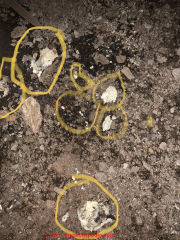 I have a business that’s in an old building that has a HUGE dirt floor basement that also had tons of old building materials and garbage from the landlord remodeling apartments stacked all over the floor. My space had begun to smell horrible but I didn’t know what it was.
I have a business that’s in an old building that has a HUGE dirt floor basement that also had tons of old building materials and garbage from the landlord remodeling apartments stacked all over the floor. My space had begun to smell horrible but I didn’t know what it was.
I had begun to develop some breathing, swallowing and skin issues. I was told in mid March that a main city water line had broken back in December and flooded the basement with a foot of water.
They let it soak into the dirt and did nothing to dry it out.
There were also a couple of leaking sewer pipes that I wasn’t aware of. I’m leaving a lot of details out and just trying to give you a brief overview of the situation. I would like to share some images and ask if you have any idea at all what kind of fungus’ are down there?
It’s really awful and smells like ammonia, mixed with sewer. It’s hard to explain.
On 2021-05-07 by (mod)
@Jennifer,
Yes there may be a soil fungus in your photos though the image isn't quite clear;White debris can be something else, even toilet paper if there was a sewage backup.
More important is the amount of water and moisture under the building which risks mold contamination in other areas including on the underside of the floor above. It seems that you need a more thorough inspection of the building.
Watch out: sewage leaks under buildings can create serious health hazards for the building occupants if not properly-cleaned up.
I add that identifying the general and species of that fungus is not important in that it's not going to change the steps that are needed which are
Find and remove the mold
And fix its cause
On 2020-12-04 by John - is this stuff under my crawl space plastic mold?
This appeared under a non-sealed plastic vapor barrier in the crawl space my home last year.
This was the largest of 4 that were discovered in Fall 2019, and although removed and ground scraped of all residue, 4 slightly smaller ones were discovered in Fall of 2020. The crawl space is otherwise dry and free of mold including all wood surfaces.
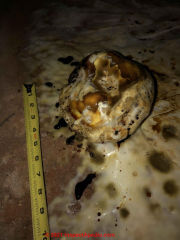
On 2020-12-04 by (mod)
John
Yes that looks like a fungus, no surprise considering the environment, dark wet soil; you'll want to be sure that your ground cover is continuous, un-damaged, and lapped well up walls at the perimeter.
On 2020-07-14 by Katie - very moldy crawl space - white stuff hanging from floor joists - what to do?
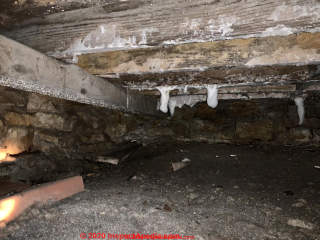 Hi, I found this in our 1920s crawl space.
Hi, I found this in our 1920s crawl space.
The space is damp, and there's patchy mold growth visible on the joists and subfloor, but there's also these drippy looking white structures.
Any idea what this is?
Thank you!!
On 2020-07-14 - by (mod) - Warnings about this moldy crawl space
Katie: thanks for a great mold photo.
That's a very moldy crawl space; the white drippy stuff is probably mycelia - part of the fungal structure; I'd be on the lookout for structural rot too.I note that the home uses a stone foundation wall; it can be difficult to keep water from leaking through any foundation wall but especially dry-laid stone.
Essential is to direct roof spillage and surface runoff away from the building, and
then to dry out the crawl area.
See CRAWL SPACE DRY-OUT PROCEDURE
Watch out: If I were inspecting this home I'd look for moisture related issues throughout the whole building, even the attic or roof space, as moisture travels upwards through the structure.
On 2020-07-14 by Katie
Thank you for that! Do you have any suggestions on next steps? You're a wealth of knowledge!! Should we hire a remediator? Do you think a vapor barrier would be helpful?
On 2020-07-14 - by (mod) -
My most thorough, well-organized, and aesthetically pleasing advice will be found in the article link that I suggested to you earlier about drying out the crawl space. That is going to be the place to start.
You'll want to remove the mold by cleaning if the mold has not resulted in or the water has not resulted in actual structural Rod that needs to be replaced. Following cleaning as when you can complete the dry out procedures if you don't do that the problem will simply recur
On 2020-07-15 by Katie
Aesthetically pleasing advice - LOL. Yes, sorry. When I asked about next steps, I had not noticed the link yet. Thank you so much for all the great information and thoughtful responses!
On 2019-10-31 by Michael - mushrooms growing in our garage?
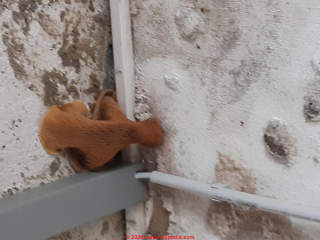 Hi,
Hi,
I found your informative site after an hour or so of trying to find similar pictures to a mold/mushroom/fungus that I discovered in my garage yesterday. I only noticed it after it dropped a clear liquid next to me. They seem to be growing out of the darker patches of moist paint/plaster.
Would that interest you to feature the photo? If you did, it might help me know what I could do about it. [Photo shown above]
Thanks and regards,
Michael
On 2019-10-31 - by (mod) - mold (or fungi) producing mushrooms growing on indoor surfaces
Michael
Thanks for the photo and question.
Other examples of mold (or fungi) producing mushrooms growing on indoor surfaces are at
YELLOW MOLD PHOTOS
and separately at
MOLD APPEARANCE on VARIOUS SURFACES we provide a large catalog of photos of what mold looks like growing on all sorts of building materials and surfaces.
What is the material and what are we looking at in your garage photo: this looks to me like a concrete or other masonry wall skim coated with a moisture-resistant paint.Those blistered spots in the right side of the image look like paint being pushed off of the wall by moisture and probably by efflorescence - a mineral salt that forms as water moves through the wall and evaporates on the inner surface.
Some of the dark areas in the paint are likely to be one or more species of mold.
The "Mushroom" in your photo is simply confirmation that the area has been wet and that one of the mold species produced its fruiting body.
Am I right that this is a wall and that it's below ground level? If so your outside focus will be on getting water away from the building by addressing surface runoff and / or overflowing roof gutters.
Indoors, you can use any common cleaner to clean the surfaces and let them dry. But don't bother re-coating the wall before the water problem has been addressed.
Finally, knowing the genera/species of mold won't change the cleanup procedure; from the little we know here there's no justification for any further testing. Remove the mold and fix its cause.Also see MOLD on PLASTER CEILINGS, WALLS where we'll include your photo. Thanks again: working together makes us smarter.
On 2019-11-17 by Michael
Many thanks for the detailed response. It definitely proves your competence, as every one of your predictions of further details were correct; very astute.
I had to check with the owner's son about the wall material etc, but it is indeed a concrete wall, and he believes the paint was moisture resistant.
I have removed the fungus, brushed down the wall and knocked off the darker patches (wore a mask, just to be sure). I've dried the wall using heaters and heat guns, but the underlying problem as you said was moisture insidr the wall.
It is un the garage which as you rightly deducted is underground, as the garden comes up a level around the house. Having investigated, the garden patio where it meets the problem wall has perforations all the way along; each large enough to accommodate a fat ant to pass through.Not sure how or why those holes have started, but it explains perfectly how the wall can get so wet. This is the thing that I'll need to fix.
Further, the garage used to be a chicken coup, 80 years ago. And there was a metal chimney of sorts, of which the stove pipe is still in place in the unused outhouse the level above...turns out, with the current cold weather, water had been condensing on the inside of this pipe and running down and out in the garage, exactly where the 2 mushrooms were.
Once I get the patio/wall holes filled, I can tackle the metal pipe then re-dry the wall and paint it.
Many thanks for your invaluable help.On 2019-11-17 - by (mod) - keep the water out from outside
Michael
Thanks for the compliments. Actually I'm just a 13 year old kid typing from my smartphone in Guanajuato, Mexico. It's dry here but we still see mold growth from time to time. (ok just kidding).
Comments:
It's always better to keep the water out from outside than to let it come in and then try to get rid of it; but beyond trying to seal the wall inside or out, at most homes the most-important step is to keep the roof drainage system working: clean gutters, unclogged downspouts, and downspouts take water 10' or more away from the building and dump it where it doesn't run back towards the foundation.
In-slope grade close to the foundation also sends un-wanted water in that direction.
Your detective work on noticing the abandoned metal chimney pipe as a source of moisture is great: I'd like to see some photos (one per comment is what works);
That too is best fixed from the roof-side (don't fall off the roof);
But the condensation also tells us there's a high indoor moisture level; In addition to stopping water entry as we've discussed, look for other moisture sources.
On 2018-09-04 by Rhonda McVicker - cleaning the heating system will not fix a mold contamination problem that originates outside of the heating system air handler and ductwork.
My daughter is renting an apartment that has a dirt crawl space where her furnace is located.
We did an air test for mold and it cultured out a lot of mold. If the furnace is serviced along with the ducts will this fix the problem or will the dirt basement continue to be a problem? The dirt has thick plastic over it and the ductwork is insulated.
On 2018-09-04 by (mod) - We did an air test for mold and it cultured out a lot of mold.
No, Rhonda.
If the building has a mold contamination problem cleaning the heating system will not fix a mold contamination problem that originates outside of the heating system air handler and ductwork.
You'd need to find and remove the mold and find and fix its cause.
...
Continue reading at CRAWLSPACE MOLD ADVICE or select a topic from the closely-related articles below, or see the complete ARTICLE INDEX.
Or see MOLD on DIRT FAQs - questions and answers posted originally on this page.
Or see these
Recommended Articles
- CRAWL SPACE DRYOUT
- MOLD APPEARANCE - WHAT MOLD LOOKS LIKE - details of what mold looks like on various building surfaces.
- MOLD CONTAMINATION IN BUILDINGS - home
- MOLD CLEANUP GUIDE- HOW TO GET RID OF MOLD - home
- MOLD CLEANUP - MISTAKES to AVOID
- MUSHROOMS IN or NEAR BUILDINGS
Suggested citation for this web page
MOLD on DIRT FLOORS at InspectApedia.com - online encyclopedia of building & environmental inspection, testing, diagnosis, repair, & problem prevention advice.
Or see this
INDEX to RELATED ARTICLES: ARTICLE INDEX to MOLD CONTAMINATION & REMEDIATION
Or use the SEARCH BOX found below to Ask a Question or Search InspectApedia
Ask a Question or Search InspectApedia
Try the search box just below, or if you prefer, post a question or comment in the Comments box below and we will respond promptly.
Search the InspectApedia website
Note: appearance of your Comment below may be delayed: if your comment contains an image, photograph, web link, or text that looks to the software as if it might be a web link, your posting will appear after it has been approved by a moderator. Apologies for the delay.
Only one image can be added per comment but you can post as many comments, and therefore images, as you like.
You will not receive a notification when a response to your question has been posted.
Please bookmark this page to make it easy for you to check back for our response.
IF above you see "Comment Form is loading comments..." then COMMENT BOX - countable.ca / bawkbox.com IS NOT WORKING.
In any case you are welcome to send an email directly to us at InspectApedia.com at editor@inspectApedia.com
We'll reply to you directly. Please help us help you by noting, in your email, the URL of the InspectApedia page where you wanted to comment.
Citations & References
In addition to any citations in the article above, a full list is available on request.
- A BRIEF GUIDE to MOLD, MOISTURE, and YOUR HOME, [PDF] U.S. Environmental Protection Agency US EPA - includes basic advice for building owners, occupants, and mold cleanup operations. See http://www.epa.gov/mold/moldguide.htm
- US EPA - UNA BREVA GUIA a MOHO / HONGO - en Espanol
- "Management of Powdery Mildew, Leveillula taurica, in Greenhouse Peppers," Ministry of Agriculture and Lands, British Columbia - Original source: www.agf.gov.bc.ca/cropprot/peppermildew.htm
- Fifth Kingdom, Bryce Kendrick, ISBN13: 9781585100224, - we recommend the CD-ROM version of this book.
- In addition to citations & references found in this article, see the research citations given at the end of the related articles found at our suggested
CONTINUE READING or RECOMMENDED ARTICLES.
- Carson, Dunlop & Associates Ltd., 120 Carlton Street Suite 407, Toronto ON M5A 4K2. Tel: (416) 964-9415 1-800-268-7070 Email: info@carsondunlop.com. Alan Carson is a past president of ASHI, the American Society of Home Inspectors.
Thanks to Alan Carson and Bob Dunlop, for permission for InspectAPedia to use text excerpts from The HOME REFERENCE BOOK - the Encyclopedia of Homes and to use illustrations from The ILLUSTRATED HOME .
Carson Dunlop Associates provides extensive home inspection education and report writing material. In gratitude we provide links to tsome Carson Dunlop Associates products and services.


